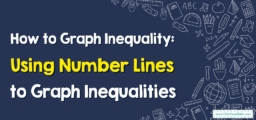How to Graph Solutions to Linear Inequalities?

Step 1: Identifying the inequality you want to graph
Step 2: Rewrite the inequality
Step 3: Draw a number line and label it
Step 4: Draw a circle on the number line
Step 5: Draw an arrow pointing in the direction
Step 6: Label the shaded region to indicate which inequality it represents
Step 7: Repeat these steps for any additional inequalities that you need to graph
Graphing Solutions to Linear Inequalities – Examples 1
Solution:
Graphing Solutions to Linear Inequalities – Examples 2
Solution:
To graph this inequality on a number line, we need to isolate the variable \(x\) on one side of the inequality. Adding \(6x\) to both sides, we get:
\(2x + 2 ≥ -1\)
Now, subtracting \(2\) from both sides, we get:
\(2x ≥ -3\)
Finally, dividing both sides by \(2\), we get:
\(x ≥ -\frac{3}{2}\)
To graph this solution on a number line, we start by drawing a line and marking a point at \(-\frac{3}{2}\). Since \(x\) is greater than or equal to \(-\frac{3}{2}\), we shade the region to the right of the point. The graph should look like this:
Exercises for Graphing Solutions to Linear Inequalities
Graph the solution of each inequality.
- \(\color{blue}{4x+3\ge 2x+11}\)
- \(\color{blue}{\frac{x}{9}-6\le 4}\)
- \(\color{blue}{4x+3\ge 2x+11}\)
- \(\color{blue}{\frac{x}{9}-6\le 4}\)
Related to This Article
More math articles
- CBEST Math Practice Test Questions
- 3rd Grade MCAS Math Worksheets: FREE & Printable
- 3rd Grade MCAS Math Practice Test Questions
- Top 10 Tips to Create an AFOQT Math Study Plan
- Polygon Names
- 3rd Grade IAR Math Worksheets: FREE & Printable
- How to Write the Equation of a Sine Graph
- AFOQT Math FREE Sample Practice Questions
- 7th Grade K-PREP Math Worksheets: FREE & Printable
- How to Convert Place Values?













What people say about "How to Graph Solutions to Linear Inequalities? - Effortless Math: We Help Students Learn to LOVE Mathematics"?
No one replied yet.